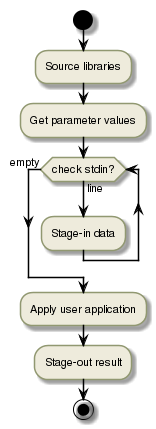Run executable design patterns¶
A processing task triggers the execution of a run executable.
The run executable reads the inputs via the stdin channel as if one would do:
$ echo "file1\nfile2" | myExecutable
This section defines typical design patterns which include:
- sourcing the required libraries (bash and Python are available; R is in beta)
- get parameter values
- reading the stdin
- stage-in/out
- apply user processing
There are two standard design patterns:
- Process n inputs to generate n (or m) outputs (parallel)
- Process n inputs to generate one output (aggregation)
And there auxiliary nodes that do not process the inputs but arrange and/or combine them for subsequent nodes in the workflow.
Process n inputs and generate n (or m) outputs¶
This design pattern processes inputs independently from one another. There will several processing task processing a number of inputs each.
The typical structure of such a run executable is:

Below you find templates implementing this design pattern:
Process n inputs to generate one output¶
This design pattern processes all inputs to generate the result. There will one single processing task processing all the inputs.
The typical structure of such a run executable is:

Auxiliary nodes¶
Auxiliary nodes are needed when the output of a node cannot be directly processed by the subsequent nodes (e.g. parallel processing would not be possible).
These nodes usually process the data by reference (no stage-in) and combines or arranges these references and provides those references as outputs.
Typical examples are:
- Group catalogue products by periods of time (e.g. produce daily aggregated products)
- Couple RADAR SAR master/slave images in the interferometry domain
